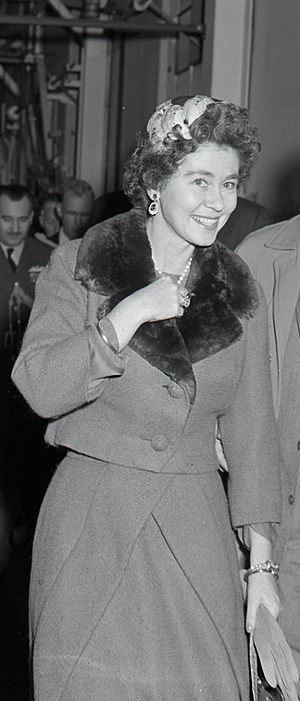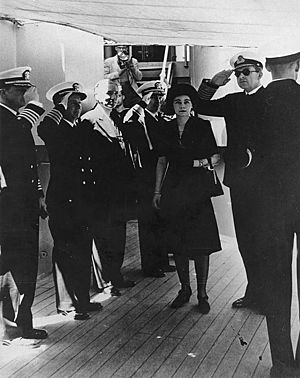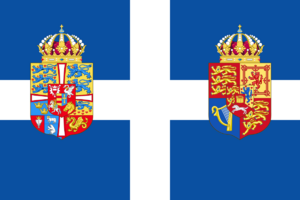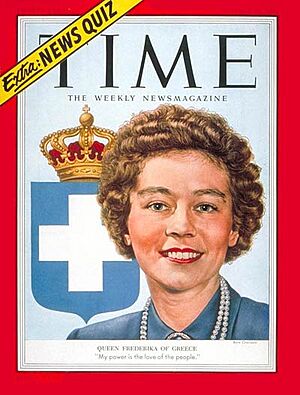Frederica of Hanover facts for kids
Quick facts for kids Frederica of Hanover |
|||||
|---|---|---|---|---|---|

Frederica in 1958
|
|||||
| Queen consort of the Hellenes | |||||
| Tenure | 1 April 1947 – 6 March 1964 | ||||
| Born | 18 April 1917 Blankenburg (Harz), Duchy of Brunswick, German Empire |
||||
| Died | 6 February 1981 (aged 63) Madrid, Kingdom of Spain |
||||
| Burial | 12 February 1981 Royal Cemetery, Tatoi Palace, Greece |
||||
| Spouse | |||||
| Issue | |||||
|
|||||
| House | Hanover | ||||
| Father | Ernest Augustus, Duke of Brunswick | ||||
| Mother | Princess Victoria Louise of Prussia | ||||
| Signature |  |
||||
Frederica of Hanover (born April 18, 1917 – died February 6, 1981) was the Queen of Greece. She was married to King Paul and served as Queen from April 1, 1947, to March 6, 1964.
Contents
Early Life of Queen Frederica
Frederica was born on April 18, 1917, in Blankenburg (Harz), a town in Germany. Her full name was Friederike Luise. Her father was Ernest Augustus, Duke of Brunswick, and her mother was Princess Victoria Louise of Prussia. Her mother was also the only daughter of the German Emperor Wilhelm II.
Family Changes After World War I
After World War I ended in November 1918, both Frederica's father and her grandfather (the German Emperor) gave up their royal positions. This meant they were no longer rulers. Her paternal grandfather had also lost his British royal title the year before.
A Royal Marriage Proposal
In 1934, when Frederica was 17, Adolf Hitler suggested that she marry the Prince of Wales from Britain. Hitler hoped this marriage would create a strong link between the British and German royal families. However, Frederica's parents were surprised by this idea. They felt the Prince of Wales was too much older than Frederica (23 years older). They also did not want to force their daughter into a marriage she might not want.
Her family often called her Freddie.
Marriage to Prince Paul of Greece
Prince Paul of Greece proposed to Frederica in the summer of 1936. This happened while he was in Berlin for the 1936 Summer Olympics. Paul was the son of King Constantine I. This made him Frederica's cousin.
Engagement and Wedding Details
Their engagement was officially announced on September 28, 1937. Britain's King George VI gave his permission for the marriage. Frederica and Paul were married in Athens, Greece, on January 9, 1938. After their marriage, Frederica became the Hereditary Princess of Greece. This meant her husband, Paul, was next in line to become king because his older brother, King George II, had no children.
Life as a Young Royal Couple
Early in their marriage, they lived in a villa in Psychiko, a suburb of Athens. Their first child, Sofia, was born on November 2, 1938. She later became the Queen of Spain. Their son, Constantine II, who would become King, was born on June 2, 1940.
War and Life in Exile
When World War II was at its peak in April 1941, the Greek Royal Family had to leave Greece. They were first taken to Crete by a special flying boat. Soon after, German forces attacked Crete. Frederica and her family had to leave again. They moved to London, where the Greek government-in-exile was set up.
Life in South Africa and Egypt
While in exile, King George II and the rest of the Greek Royal Family settled in South Africa. Frederica's youngest child, Princess Irene, was born there on May 11, 1942. The South African leader, General Jan Smuts, became Irene's godfather. The family later moved to Egypt in February 1944.
After the war, a vote in Greece in 1946 brought King George II back to the throne. Frederica and Paul returned to their home in Psychiko.
Becoming Queen of Greece
On April 1, 1947, King George II passed away. Frederica's husband became King Paul I, and Frederica became the queen consort of Greece. At this time, a Greek Civil War was happening in Northern Greece. The King and Queen traveled through Northern Greece to encourage people to support the monarchy.
Facing Criticism as Queen
Queen Frederica faced criticism because of her German background. Some politicians in Greece used the fact that her grandfather was the Kaiser (German Emperor) against her. They also mentioned that her brothers had been part of a German youth group. People sometimes called her "very Prussian" or even "a Nazi."
When she visited London in 1947 for a royal wedding, Winston Churchill mentioned her grandfather. Queen Frederica replied that while her grandfather was the Kaiser, she was also a descendant of Queen Victoria of Britain.
Helping Children During the Civil War
During the civil war, Queen Frederica started the "Queen's Camps" or "Child Cities." These were a network of 53 camps across Greece. Her goal was to help and protect children who had been affected by the war.
After the Civil War
The Greek Civil War ended in August 1949. The King and Queen then made official visits to many countries. They visited leaders in Belgrade, Rome, West Germany, Lebanon, Ethiopia, India, the United Kingdom, and the United States.
However, Queen Frederica continued to be a target of opposition. This was partly because as a girl, she had been part of the Bund Deutscher Mädel (League of German Girls). This was a branch of the Hitler Youth for young women. Her supporters argued that it was very difficult to avoid joining such groups in Nazi Germany at that time.
Political Involvement and Public Opinion
Frederica was known for being involved in Greek politics. She sometimes clashed with the elected governments. This led to her being disliked by many people. She was seen as someone who interfered too much and was "undemocratic." In 1963, while visiting London, she had to seek safety in a stranger's house because of protests by Greek leftists. Her political actions were a big reason why many Greeks started to support a republic instead of a monarchy.
In 1953, she appeared on the cover of Time magazine. On May 14, 1962, her oldest daughter, Sofia, married Prince Juan Carlos of Spain in Athens. He later became King Juan Carlos I of Spain.
Queen Dowager Role
On March 6, 1964, King Paul died from cancer. Later that year, on September 18, her son, King Constantine II, married Princess Anne-Marie of Denmark. After this, Queen Frederica stepped back from most of her public duties. She let her daughter-in-law take on more responsibilities. However, she was still seen by some as having influence behind the scenes.
She moved to the countryside and lived a quiet life. She still attended family royal events, like the baptisms of her grandchildren in Spain and Greece.
Life in Exile
King Constantine II had disagreements with the elected Prime Minister George Papandreou Sr.. Some critics believe these disagreements caused instability. This instability led to a military takeover on April 21, 1967. This was the start of the regime of the colonels.
Initially, King Constantine worked with the military government. However, later that year, he tried to overthrow the military rulers to bring back democracy. His attempt failed, and he was forced to leave Greece and live in exile. After this, the military government appointed someone to act as ruler in place of the exiled King.
In 1971, Frederica wrote a book about her life called A Measure of Understanding.
End of the Monarchy in Greece
On June 1, 1973, the military government officially ended the Greek Monarchy. They did this without asking the Greek people first. They then tried to make this decision seem legal through a vote in 1973, but many suspected the vote was unfair. Georgios Papadopoulos became the new head of state.
The military dictatorship ended on July 24, 1974. The monarchy was not brought back. A new vote was held on December 8, 1974. In this vote, King Constantine (who could only campaign from outside Greece) admitted past mistakes and promised to support democracy. However, 69% of Greeks voted to make Greece a democratic republic.
Death and Burial
Frederica died on February 6, 1981, in exile in Madrid, Spain. She passed away from heart failure after an eyelid surgery. Some reports say it was for cataracts.
She was buried at Tatoi, which is the royal family's palace and burial ground in Greece. Her son and his family were allowed to attend the funeral service. However, they had to leave Greece immediately afterward.
Honours and Awards
| Styles of Queen Frederica of Greece |
|
|---|---|
 |
|
| Reference style | Her Majesty |
| Spoken style | Your Majesty |
- Greece: Grand Cross of the Order of the Redeemer
- Denmark: Knight of the Order of the Elephant
- Italy: Knight Grand Cross of the Order of Merit of the Italian Republic
- Thailand: Dame Grand Cordon with Chain of the Order of the Royal House of Chakri
Images for kids
See also
 In Spanish: Federica de Hannover para niños
In Spanish: Federica de Hannover para niños






